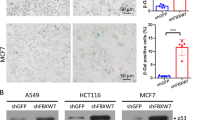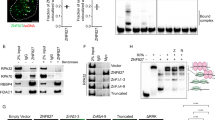Abstract
In response to DNA damage, eukaryotic cells initiate a complex signalling pathway, termed the DNA damage response (DDR), which coordinates cell cycle arrest with DNA repair. Studies have shown that oncogene-induced senescence, which provides a barrier to tumour development, involves activation of the DDR1,2,3. Using a genome-wide RNA interference (RNAi) screen, we have identified 17 factors required for oncogenic BRAF to induce senescence in primary fibroblasts and melanocytes4. One of these factors is an F-box protein, FBXO31, a candidate tumour suppressor encoded in 16q24.3, a region in which there is loss of heterozygosity in breast, ovarian, hepatocellular and prostate cancers5,6,7,8,9. Here we study the cellular role of FBXO31, identify its target substrate and determine the basis for its growth inhibitory activity. We show that ectopic expression of FBXO31 acts through a proteasome-directed pathway to mediate the degradation of cyclin D1, an important regulator of progression from G1 to S phase, resulting in arrest in G1. Cyclin D1 degradation results from a direct interaction with FBXO31 and is dependent on the F-box motif of FBXO31 and phosphorylation of cyclin D1 at Thr 286, which is known to be required for cyclin D1 proteolysis. The involvement of the DDR in oncogene-induced senescence prompted us to investigate the role of FBXO31 in DNA repair. We find that DNA damage induced by γ-irradiation results in increased FBXO31 levels, which requires phosphorylation of FBXO31 by the DDR-initiating kinase ATM. RNAi-mediated knockdown of FBXO31 prevents cells from undergoing efficient arrest in G1 after γ-irradiation and markedly increases sensitivity to DNA damage. Finally, we show that a variety of DNA damaging agents all result in a large increase in FBXO31 levels, indicating that induction of FBXO31 is a general response to genotoxic stress. Our results reveal FBXO31 as a regulator of the G1/S transition that is specifically required for DNA damage-induced growth arrest.
This is a preview of subscription content, access via your institution
Access options
Subscribe to this journal
Receive 51 print issues and online access
$199.00 per year
only $3.90 per issue
Buy this article
- Purchase on Springer Link
- Instant access to full article PDF
Prices may be subject to local taxes which are calculated during checkout




Similar content being viewed by others
References
Bartkova, J. et al. Oncogene-induced senescence is part of the tumorigenesis barrier imposed by DNA damage checkpoints. Nature 444, 633–637 (2006)
Di Micco, R. et al. Oncogene-induced senescence is a DNA damage response triggered by DNA hyper-replication. Nature 444, 638–642 (2006)
Mallette, F. A., Gaumont-Leclerc, M. F. & Ferbeyre, G. The DNA damage signaling pathway is a critical mediator of oncogene-induced senescence. Genes Dev. 21, 43–48 (2007)
Wajapeyee, N., Serra, R. W., Zhu, X., Mahalingam, M. & Green, M. R. Oncogenic BRAF induces senescence and apoptosis through pathways mediated by the secreted protein IGFBP7. Cell 132, 363–374 (2008)
Lin, Y. W. et al. Deletion mapping of chromosome 16q24 in hepatocellular carcinoma in Taiwan and mutational analysis of the 17β-HSD gene localized to the region. Int. J. Cancer 93, 74–79 (2001)
Launonen, V. et al. Loss of heterozygosity at chromosomes 3, 6, 8, 11, 16, and 17 in ovarian cancer: correlation to clinicopathological variables. Cancer Genet. Cytogenet. 122, 49–54 (2000)
Harkonen, P., Kyllonen, A. P., Nordling, S. & Vihko, P. Loss of heterozygosity in chromosomal region 16q24.3 associated with progression of prostate cancer. Prostate 62, 267–274 (2005)
Miller, B. J., Wang, D., Krahe, R. & Wright, F. A. Pooled analysis of loss of heterozygosity in breast cancer: a genome scan provides comparative evidence for multiple tumor suppressors and identifies novel candidate regions. Am. J. Hum. Genet. 73, 748–767 (2003)
Kumar, R. et al. FBXO31 is the chromosome 16q24.3 senescence gene, a candidate breast tumor suppressor, and a component of an SCF complex. Cancer Res. 65, 11304–11313 (2005)
Ho, M. S., Tsai, P. I. & Chien, C. T. F-box proteins: the key to protein degradation. J. Biomed. Sci. 13, 181–191 (2006)
Alao, J. P. The regulation of cyclin D1 degradation: roles in cancer development and the potential for therapeutic invention. Mol. Cancer 6, 24 (2007)
Diehl, J. A., Zindy, F. & Sherr, C. J. Inhibition of cyclin D1 phosphorylation on threonine-286 prevents its rapid degradation via the ubiquitin–proteasome pathway. Genes Dev. 11, 957–972 (1997)
Diehl, J. A., Cheng, M., Roussel, M. F. & Sherr, C. J. Glycogen synthase kinase-3β regulates cyclin D1 proteolysis and subcellular localization. Genes Dev. 12, 3499–3511 (1998)
Okabe, H. et al. A critical role for FBXW8 and MAPK in cyclin D1 degradation and cancer cell proliferation. PLoS ONE 1, e128 (2006)
Agami, R. & Bernards, R. Distinct initiation and maintenance mechanisms cooperate to induce G1 cell cycle arrest in response to DNA damage. Cell 102, 55–66 (2000)
Shiloh, Y. The ATM-mediated DNA-damage response: taking shape. Trends Biochem. Sci. 31, 402–410 (2006)
Elledge, S. J. Cell cycle checkpoints: preventing an identity crisis. Science 274, 1664–1672 (1996)
Zhou, B. B. & Elledge, S. J. The DNA damage response: putting checkpoints in perspective. Nature 408, 433–439 (2000)
Matsuoka, S. et al. ATM and ATR substrate analysis reveals extensive protein networks responsive to DNA damage. Science 316, 1160–1166 (2007)
Lin, D. I. et al. Phosphorylation-dependent ubiquitination of cyclin D1 by the SCFFBX4-αB crystallin complex. Mol. Cell 24, 355–366 (2006)
Newman, R. M. et al. Antizyme targets cyclin D1 for degradation. A novel mechanism for cell growth repression. J. Biol. Chem. 279, 41504–41511 (2004)
Gazin, C., Wajapeyee, N., Gobeil, S., Virabasius, C. M. & Green, M. R. An elaborate pathway required for Ras-mediated epigenetic silencing. Nature 449, 1073–1077 (2007)
Canman, C. E. et al. Activation of the ATM kinase by ionizing radiation and phosphorylation of p53. Science 281, 1677–1679 (1998)
Acknowledgements
We thank S. Cook, O. Tetsu, M. Kastan and R. Kumar for reagents; M. Pagano for reagents and advice; L. Chamberlain for technical assistance; and S. Evans for editorial assistance. N.W. is supported in part by a fellowship from the Our Danny Cancer Fund. M.R.G. is an investigator of the Howard Hughes Medical Institute.
Author Contributions M.K.S. and N.W. contributed equally to this work. M.K.S., N.W. and M.R.G. conceived and designed the experiments. M.K.S. and N.W. performed the experiments and, together with M.R.G., analysed the data and wrote the paper.
Author information
Authors and Affiliations
Corresponding author
Supplementary information
Supplementary Figures
This file contains Supplementary Figures 1-20 with Legends. (PDF 645 kb)
Rights and permissions
About this article
Cite this article
Santra, M., Wajapeyee, N. & Green, M. F-box protein FBXO31 mediates cyclin D1 degradation to induce G1 arrest after DNA damage. Nature 459, 722–725 (2009). https://doi.org/10.1038/nature08011
Received:
Accepted:
Published:
Issue Date:
DOI: https://doi.org/10.1038/nature08011
This article is cited by
-
FBXO31 is upregulated by METTL3 to promote pancreatic cancer progression via regulating SIRT2 ubiquitination and degradation
Cell Death & Disease (2024)
-
FBXW2 suppresses breast tumorigenesis by targeting AKT-Moesin-SKP2 axis
Cell Death & Disease (2023)
-
USP13 deubiquitinates and stabilizes cyclin D1 to promote gastric cancer cell cycle progression and cell proliferation
Oncogene (2023)
-
The m6A modification-mediated OGDHL exerts a tumor suppressor role in ccRCC by downregulating FASN to inhibit lipid synthesis and ERK signaling
Cell Death & Disease (2023)
-
Inhibitors Targeting the F-BOX Proteins
Cell Biochemistry and Biophysics (2023)
Comments
By submitting a comment you agree to abide by our Terms and Community Guidelines. If you find something abusive or that does not comply with our terms or guidelines please flag it as inappropriate.



